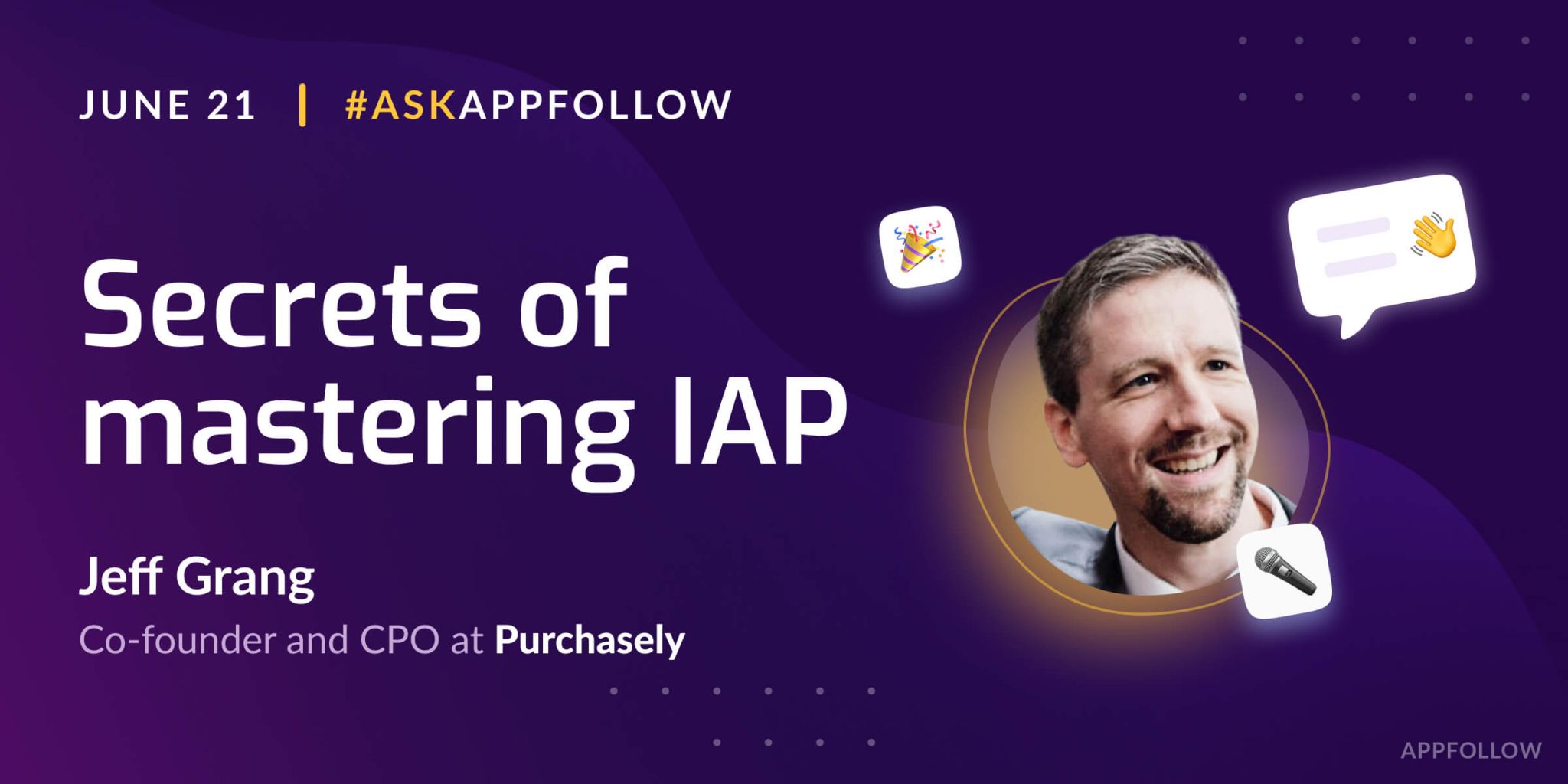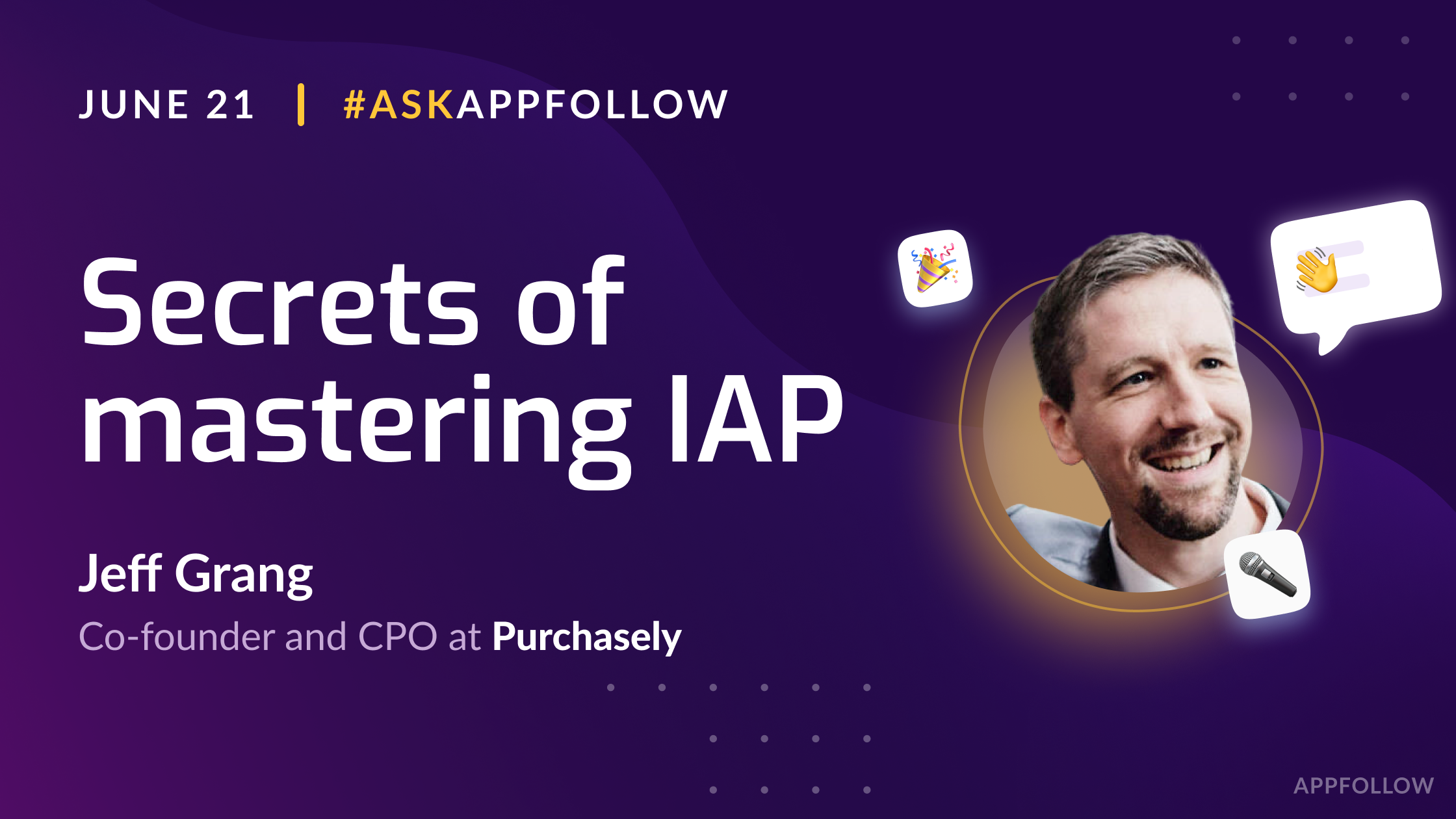We know that choosing the right In-App Purchase strategy is complex work.
There are endless details to adjust on price, free-trial period, effective messaging, etc.
That’s why last June, Purchasley’s co-founder, CPO, and mobile business development veteran Jean-François Grang participated in AppFollow’s #AskAppFollow Q&A series to share his expert tips to help App businesses find the most relevant answers to their questions.
Thank you to everyone who submitted questions and tuned in to join us live on Twitter! If you missed the live Q&A or having a hard time tracking back through the tweets, retweets, and replies, read on for the full recap to find all the answers from the Q&A!
Key topics of the Q&A
- Lifetime access - should I offer it?
- Lifetime access - what’s the right price?
- Lifetime access - when should I offer it?
- In-App Purchase - what’s the right price?
- In-App Purchase - how can I make users purchase?
- Receipt validation - can I use Apple's APIs directly?
- Subscription price sensibility - how to measure it?
- ROI - how can I improve it?
- Traveling users - how can I appeal to them?

How to choose the right In-App Purchase strategy for your app - Q&A Recap
Q1: For a freemium model, when should the lifetime access option be shown to the user? For example, is it a good idea to show it on a dedicated screen after 3 sessions if the user hasn't taken an annual or monthly subscription yet?
A1: Lifetime access is not a subscription(non-consumable) thus offering a free trial is impossible. Make sure that users understand its value in comparison with the value of a subscription.
Is your app popular(enough), and the advantages of subscribing to it are clearly known? Then, you can try to sell lifetime access alongside regular plans from the first launch.
Otherwise, you can leverage lifetime access as a great upsell strategy. Use your CRM to identify active premium users and propose them lifetime access.
Since this is not a subscription(no automatic payment), they will have to manually cancel the access. Display a post-purchase message reminding the access to cancelation, then redirect to the store settings.
Q2: How to price lifetime access?
A2: Keep in mind the long-term costs(ex. content rights for VOD apps or infrastructure for VPN apps). Make sure at the same time that your subscriptions offer a long-term value. You could also offer this option periodically to create frustration or FOMO.
The average price of a lifetime subscription is 2.8 times higher than that of a yearly subscription.
Q3: How to choose a proper #IAP for the app in case of having very high expenses for the Ads (Non-organic traffic) and having an auditorium of fewer than 1k users? Does IAP depend on the app categories?
A3: This equation might be unsolvable 😬. It's a mathematical question in the end. With a 5-10% conversion rate, how long should a subscriber stay to compensate for the acquisition costs, and how much does an IAP have to be to cut the losses and meet the breakeven point sooner?
Test different IAP and subscription prices to maximize your LTV and minimize your Payback period. You should try huge price jumps like 1,5 to 2 times the original price. You can only offer yearly subscriptions(like the app Calm)or an expensive lifetime purchase.
Q4: I'm going to use in-app subscriptions in my iOS app. I don't want to use a server for receipt validation and use Apple's APIs directly. Is there a strong reason why you wouldn't do this?
A4: It is totally fine. If your app is not on Android, Apple released StoreKit 2 (iOS 15+) which offers a way to check for the active subscription for the user on the device.
https://developer.apple.com/documentation/storekit/transaction/3851204-currententitlements
If you want to target more users reaching iOS 14 and lower and Android users, Purchasely offers a way to get the active subscriptions of a user from its mobile SDK without having to write server code. You will also get real-time data and dashboards in the process.
https://docs.purchasely.com/advanced-features/subscription-status
Q5: How to measure subscription price sensibility in the stores?
A5: Finding the right price requires tests. Price elasticity may differ from one country to another country, from one demographic to another demographic, and from one category to another category.
Many apps conduct competitor benchmarking, which is a good starting point but you should do more!
Start with a price, then test +25% and -25% variables (or more for apps with a lower user base). Use A/B/C testing over 2 to 3 months to build a solid database, then monitor its impact on retention and conversion.
One price doesn’t fit all. Test different prices in different countries. For example, subscription prices are 25 to 50% lower on average in Africa.
Q6: What would be the best strategy to provide users so they make the purchases in-app?
A6: Every attempt and strategy counts when it comes to making users purchase. 4 quick tips.
- Tip 1- 60 to 80% of subscribers are Day-0 users. A good rule of thumb is to display a paywall on the first launch and during the onboarding.
- Tip 2- Allow users to test before committing by offering a free trial.
- Tip 3- Make sure you display a lot of premium content so that freemium users hit the paywall frequently.
- Tip 4- Leverage push notifications to offer promo codes for special deals.
There are myriads of other things you can try, but I recommend starting with these basics!
Q7: How can the ROI be changed for a mobile app?
A7: You can improve ROI by reducing acquisition costs or improving your ARPU. I’ll only cover the second one. Only 4-5% of subscribed users reach 1-year retention. Try to reduce the loss at every step of the funnel.
Improve your install to trial, trial to paid, paid to 1st renewal, and paid to 1-year retention. You can also improve the LTV by trying to upsell your subscribers to higher-tier plans(silver to gold) or longer terms(monthly to yearly).
Purchasely’s customer success team offers ROI improvement insights and also collaborates with app growth consultancies like Phiture, Yodel Mobile, and Dreamin.
Q8: What are all marketing things to do to capture users who travel?
A8: That is an open question 😂. If you want to make users install your app you can leverage standard marketing strategies like airport on-site advertisement or skymall magazines. You'd also want to work on your content to provide what's more relevant for each traveler.
For example, you can push a geofenced notification coupled with a subscription paywall that displays location-specific content when leaving an airport. Purchasely’s Paywall Builder can help you easily create these kinds of paywalls on the fly.
.png)
.png)


